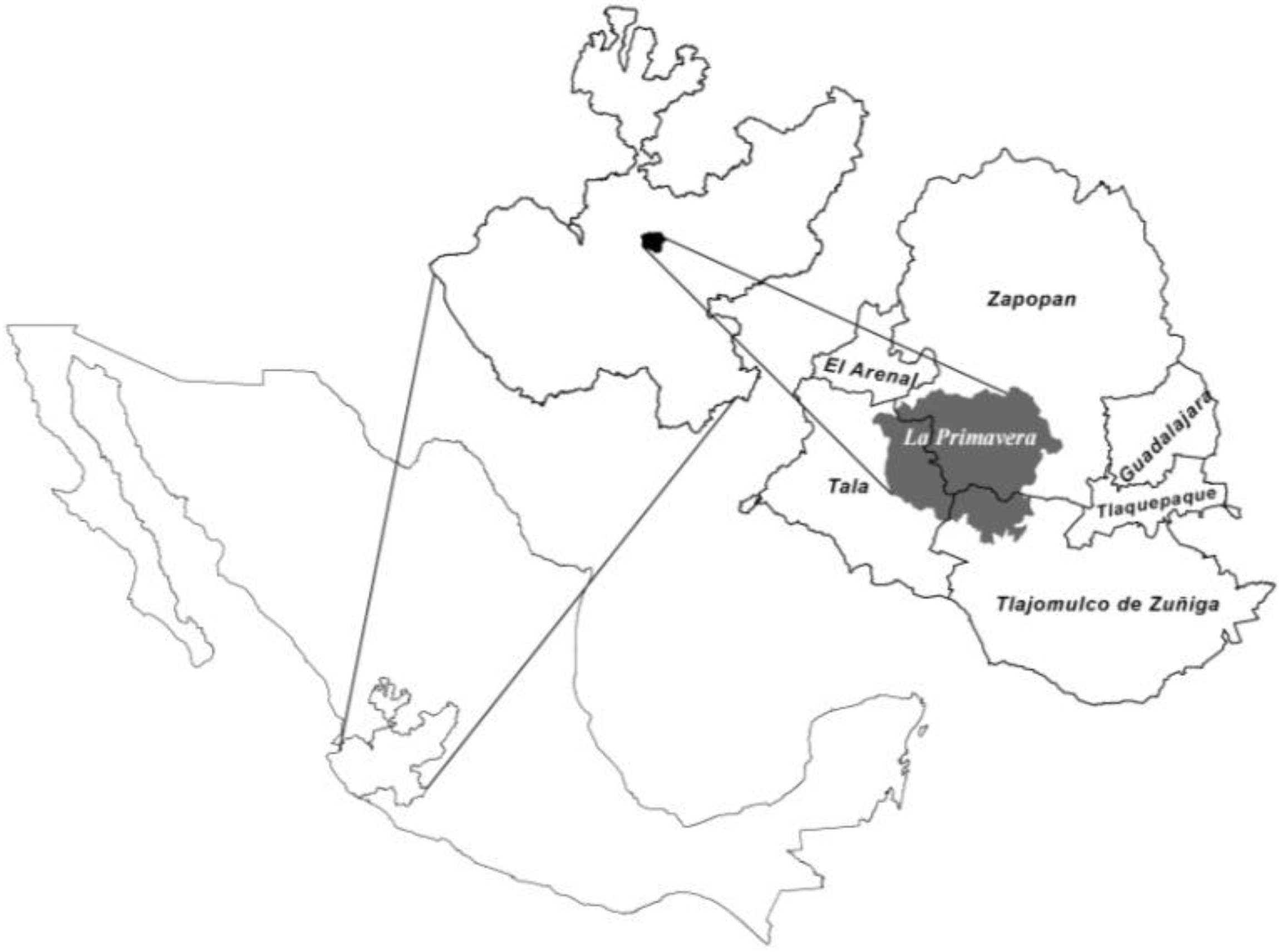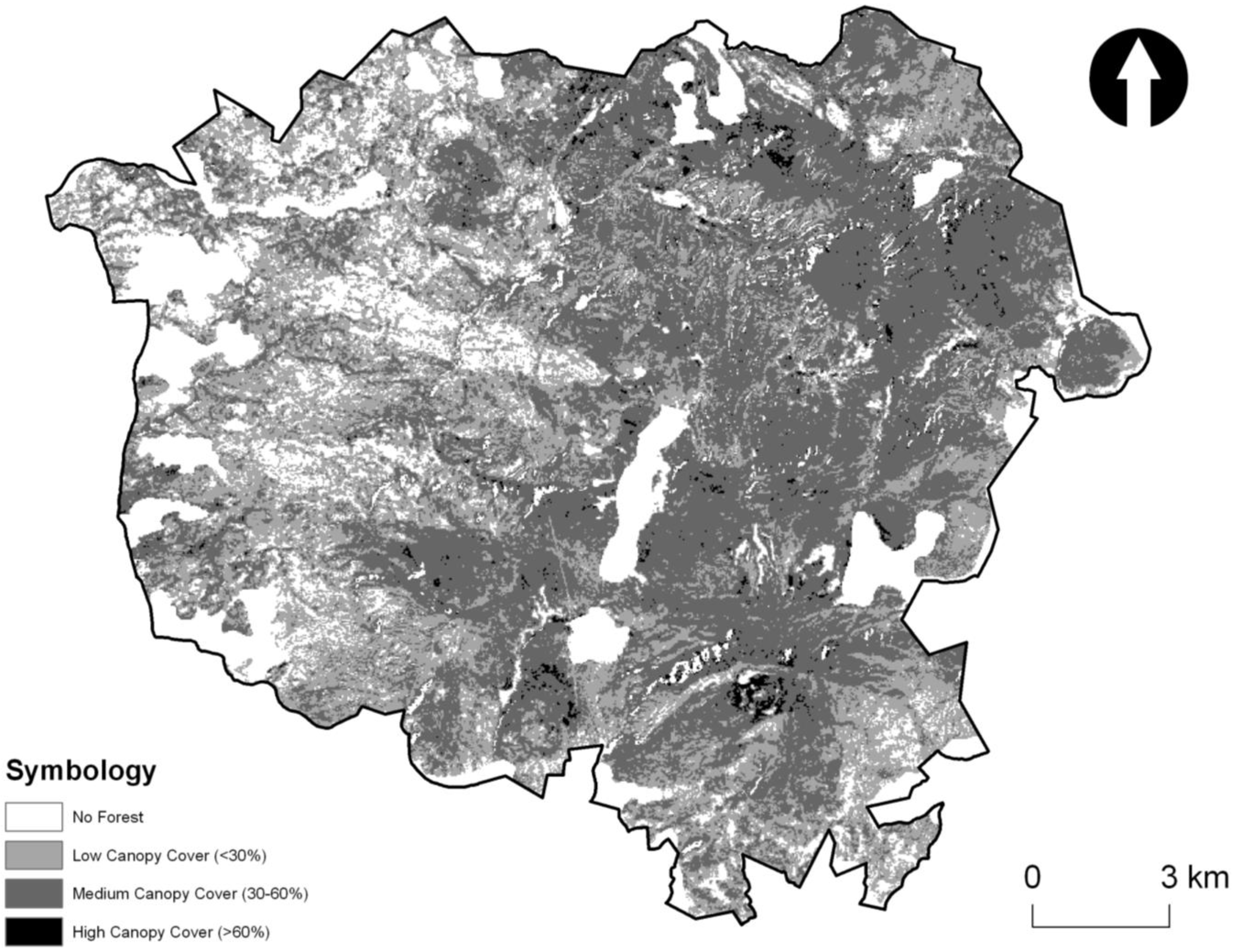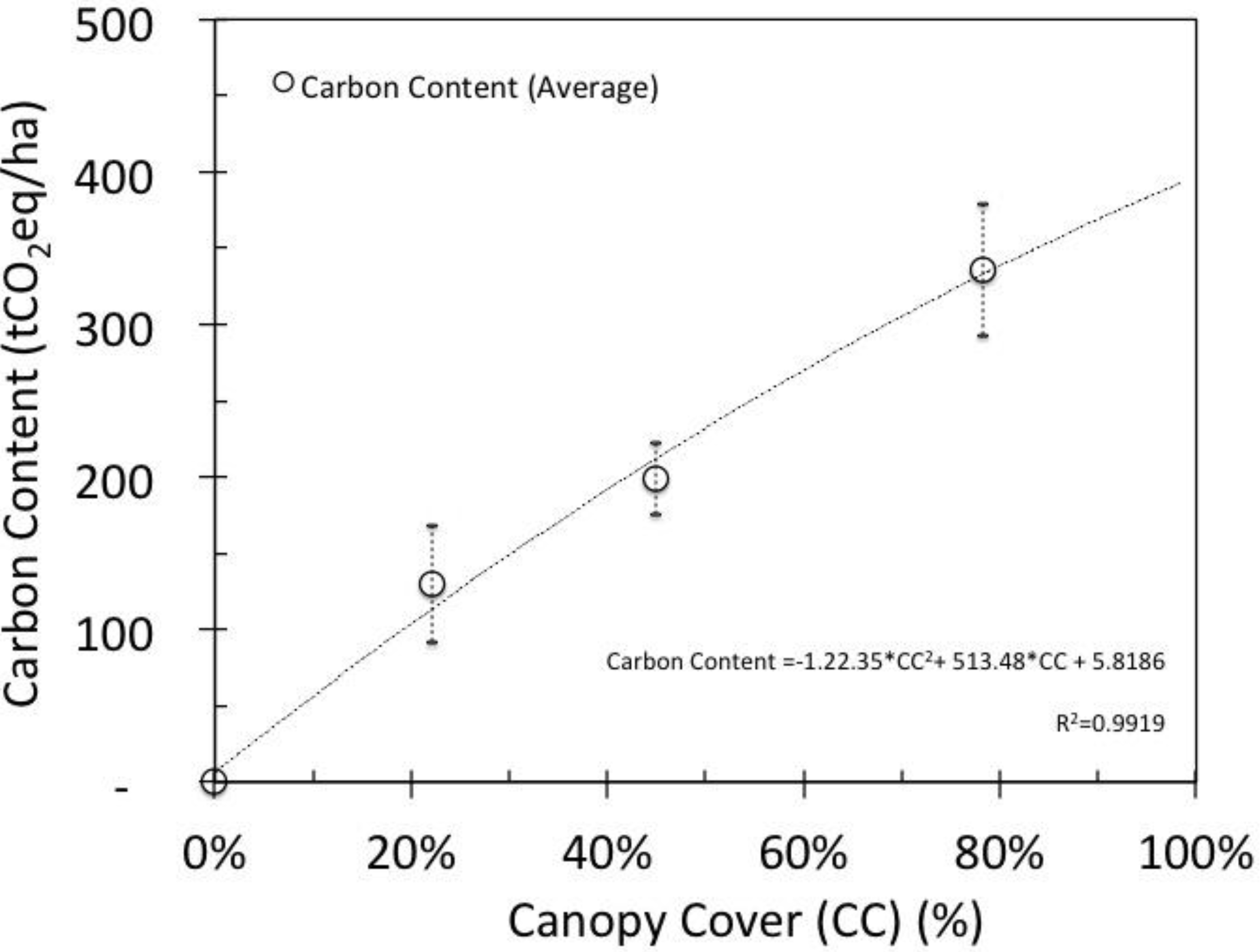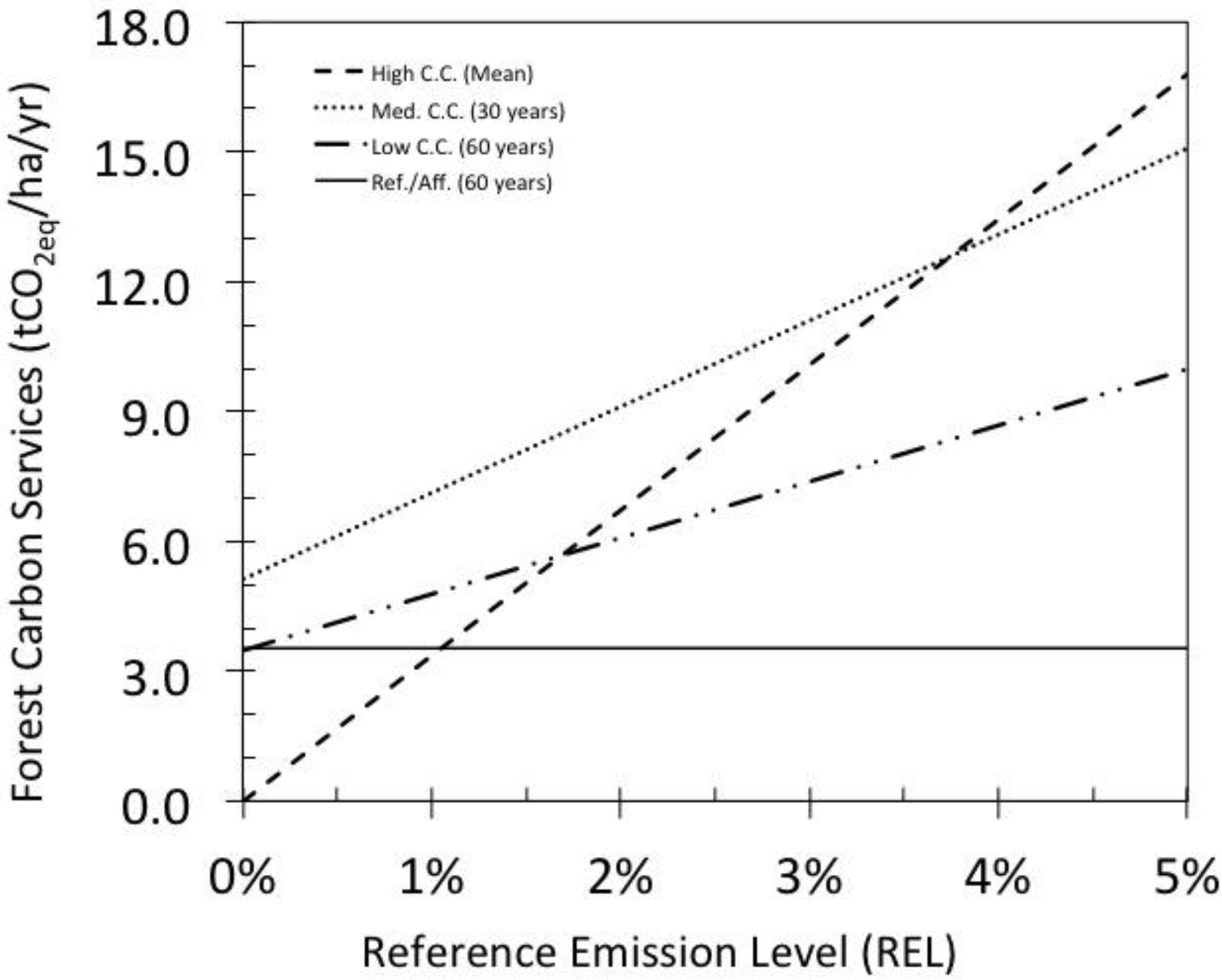2.1. Quantification of Forest Carbon Services
The basic procedure for estimating carbon stocks in forests is to obtain an estimate of carbon content or an annual carbon stock change factor per hectare and multiply it by the corresponding area of forest [
1,
7]. The IPCC has published methods to assess carbon stocks and stock changes in forests. These methodologies are used in the preparation of inventories of greenhouse gas emissions and to monitor the performance of mitigation measures. They are based on a combination of ground and remotely-sensed data (e.g., forest inventories, allometric equations or biomass expansion factors and analysis of satellite images) (e.g., [
1]). In order to prepare initial estimates, default carbon content figures for different carbon pools are available (Tier 1, under IPCC guidelines); nationally and locally derived data is used to refine the estimates for more advanced assessments (Tiers 2 and 3) [
1,
8]. Forest areas can be obtained from international or national statistics and cartography, ground data (e.g., surveys) and through the analysis of satellite imagery [
1]. Changes in carbon stocks can be obtained by performing successive inventories over a period of time to measure net growth or by the estimation of yearly gains and losses based on growth factors or models and on statistics on rates of extraction [
1]. These methods provide the basis for the development of national forest monitoring systems to estimate forest-related emissions and removals and activities under REDD+ [
9].
Agreements under the United Nations Framework Convention on Climate Change (UNFCCC) have defined different rules to account for forest carbon services in the context of the provision of positive incentives for their valuation. Carbon removals in “new” forests are considered carbon sequestration, while carbon gains occurring in existing forests under REDD+ are said to be carbon enhancements (additional to gains from reduced emissions from deforestation and forest degradation). In order to separate these two groups of carbon services, a clear definition of forests is necessary. Forests are defined in the Marrakesh Accords as areas with a minimum size of 0.05 to 1 ha, where woody plants have the potential to grow at least two to 5 m high at maturity and have a minimum canopy cover from 10% to 30% [
10]. Countries may choose their thresholds within these margins according to their national circumstances. In the Clean Development Mechanism of the Kyoto Protocol (CDM), developing countries can execute reforestation and afforestation activities in areas that have not been forested since 1990; for afforestation projects, the requirement is that the area has not been forest in the last fifty years [
10]. Thus, carbon sequestration activities can be developed in areas that are currently not forests (
i.e., cropland, grasslands and degraded land with canopy cover below the threshold for forest). Conversely, carbon enhancement and reductions in emissions from deforestation and forest degradation relate to carbon gains in forested areas with canopy cover above the threshold. To enable participation in CDM carbon markets or REDD+, countries need to communicate to the UNFCCC their definition of forests. For afforestation/reforestation projects under the CDM, México adopted the 30% threshold for canopy cover, 1 ha for minimum forest area and 4 m for minimum tree height [
11]. It is not absolutely certain that these thresholds will be adopted by México with respect to REDD+ [
12], since the definition according to the national forest law uses a 10% threshold.
For reforestation and afforestation projects, carbon removals are quantified by comparing the growth of the planted trees with the carbon stock expected according to the business as usual scenario, which describes what would have happened had the project not been implemented. Estimations of reduced emissions from deforestation and forest degradation are made on the basis of the performance of a project or intervention in comparison with the expected levels of emissions (
i.e., in the absence of the intervention) defined in a baseline or REL. If the baseline also integrates the information on carbon enhancements, then it is referred to as a forest reference level (RL) [
6]. A major hurdle is the fact that there is, in most cases, little or no historical data with the required level of detail to set the baselines for forest degradation [
13]. Furthermore, there are still no agreed guidelines on how to construct these baselines, although it has been established that countries can prepare their baselines at national and/or sub-national levels [
6]. Given the limited availability of data, a number of parties proposed to the UNFCCC Subsidiary Body for Scientific and Technological Advice (SBSTA) that at least during the early stages of REDD+, when the systems to monitor forest stocks and changes may not have been in place yet, conservative estimates of emissions reductions should be used (e.g., using Tier 1, default emissions factors or proxies) [
14,
15]. At the SBSTA expert meeting on REL/RLs in 2011, there were suggestions in favour of defining default baseline values or proxies for degradation in order to enable its inclusion in the early stages of implementation [
16]. There were also discussions about whether countries have to choose between a REL or a RL or whether they may develop both, targeting different regions in their countries [
16]; the decision on RELs/RLs leaves these two options open, but no clear decisions on these matters were made.
In the case of deforestation, carbon emissions are estimated based on changes in the rates of forest loss. For instance, if a forest loses 1% of its area per year, the carbon lost will be proportional to the initial stock of carbon in the forest; thus ceteris paribus reduced emissions will be higher in areas where forests had initially more carbon. It is important to make clear that under this rationale, it is not the level of carbon stocks that will be valuated, but the change in the rate of loss. However, the level of carbon stocks determines the expected emissions and, hence, the prospects for future reduced emissions, against a given (estimated) risk of deforestation or forest degradation. In the case of forest degradation, the baseline will refer to the annual percentage of carbon being lost from a forest that remains forest (i.e., is not converting to another land use). In this case, the potential for reduced emissions from degradation would also be related to the initial content of carbon stocks; more emissions from degradation can be expected in areas with initially higher stocks of carbon, since, clearly, those areas already degraded could soon reach the threshold for forests/non-forest if the degradation process continues (i.e., they have less carbon to lose). This highlights the importance of evaluating carbon stocks to quantify forest carbon services and the need to account for the level of degradation (i.e., the estimation of carbon stocks at different canopy cover levels); the information on canopy cover serves to identify the boundary between a forested and a non-forested area for carbon accounting. All estimates of reduced emissions require working with data that are essentially counterfactual (i.e., estimates of what would be the case in the future if the intervention were not to take place), which means they are not fully certain (baselines could be set at different levels, which would result in different assessments of the reductions).
Conversely, carbon enhancements can be readily measured at the local level through standard forest inventories when repeated measurements are undertaken (e.g., [
17]). Moreover, the growth functions of trees can be used to model forest growth and potential enhancements as part of higher Tier methods based on the IPCC methodologies. If a forest area is known to have been degraded or to be degrading prior to the commencement of REDD+ activity, any increases in stock during the REDD+ accounting period will be additional, representing forest enhancement, with the baseline taken as the level of stock measured at the beginning of this period [
17]. There will also be a (unmeasured, uncredited) reduction in degradation when the forest enhancement occurs, since the manifestation of the growth of stock implies that the degradation has been reversed [
17]; hence, the estimate of carbon impacts of the REDD+ activity would be conservative.
2.2. Study Area
La Primavera forest is a Biosphere Reserve of 30,500 ha located in the State of Jalisco in México (
Figure 1) [
18,
19]. According to its management plan, La Primavera consists mainly of oak-pine mixed forests, but natural grasslands and agricultural areas are also present. The altitude ranges from 1400 to 2200 meters above sea level (masl). Annual mean temperature is 20.6 °C (± 6 °C) and annual precipitation ranges from 800–1000 mm. Regosols and lithosols are the principal types of soils present; in general, the soil is poor and affected by erosion and recurrent fires [
18]. From 1998 to 2012, the aggregate area affected by fires was 29,722 ha [
20], including 8200 ha, which burned in April 2012 [
21].
According to the IPCC guidelines [
1,
22], La Primavera corresponds to a Tropical Montane System (
i.e., temperature > 20 °C and altitude above 1000 masl, and it would be classified as “Dry”, <1000 mm). According to the first inventory of greenhouse gas (GHG) emissions and removals in Jalisco [
23], preliminary estimates of gross losses in carbon stocks in biomass (not accounting for enhancements and other carbon pools) between 2002 and 2008 in Jalisco are around 1.01% per year, while for the municipalities of Tala, Tlajomulco and Zapopan, where La Primavera is located, the gross rates of loss of carbon stocks were 2.30%, 2.17% and 1.36%, respectively (average 1.84%). These figures are estimated following the most recent IPCC guidelines [
1] based on national cartography for the representation of land (Approach 3) [
24,
25]; emission factors at Tier 2 [
26]; and statistics on forest fires and timber production [
27,
28].
Figure 1.
Study area. The location of La Primavera in México, the State of Jalisco and neighbouring municipalities.
Figure 1.
Study area. The location of La Primavera in México, the State of Jalisco and neighbouring municipalities.
Although no earlier published forest inventory to estimate carbon stocks data were available, historical evidence indicates that carbon stocks in La Primavera are decreasing, or at least not increasing. According to La Primavera’s management plan, in 1970, the forest area was 25,764 ha, the remaining area being agriculture, grasslands and bare soil; the forested area decreased to 24,463 ha in 1990 [
18]. This change alone represents a loss of 5% of forest area over 20 years (0.3% annually). However, forested areas have also been subject to recurrent fires, most of them associated with human activities (e.g., agricultural practices or even deliberate fires set in an attempt to change land use [
29]). From 1998 to 2012, the aggregate area affected by fires was 29,722 ha (Martinez, 2012), including 8200 ha, which burned in April, 2012 [
21]. This is equivalent to 122% of the current forested area, which means that, on average, fires affect 9% of the forested areas every year. Whether these disturbances result in land conversion (e.g., forests to grasslands) and should be accounted for as definitive carbon losses (deforestation) depends on the rate of recovery of the affected areas. If affected areas fail to recover to canopy cover levels above the thresholds for forest definition in a period of 20 years, they would be reclassified in another land use category, and the forest loss would have to be accounted for, in the context of GHG inventories [
8]. However, if areas affected by fires slowly recover to previous biomass stock levels (
i.e., above the thresholds for forest definition), fires would not be considered to have resulted in land use category changes or forest loss (instead, the temporary losses would be considered to be degradation), although non-CO
2 emission from fires still would need to be accounted for [
8]. If the areas recover, but do not reach previous stock levels, net emissions from degradation could be estimated.









